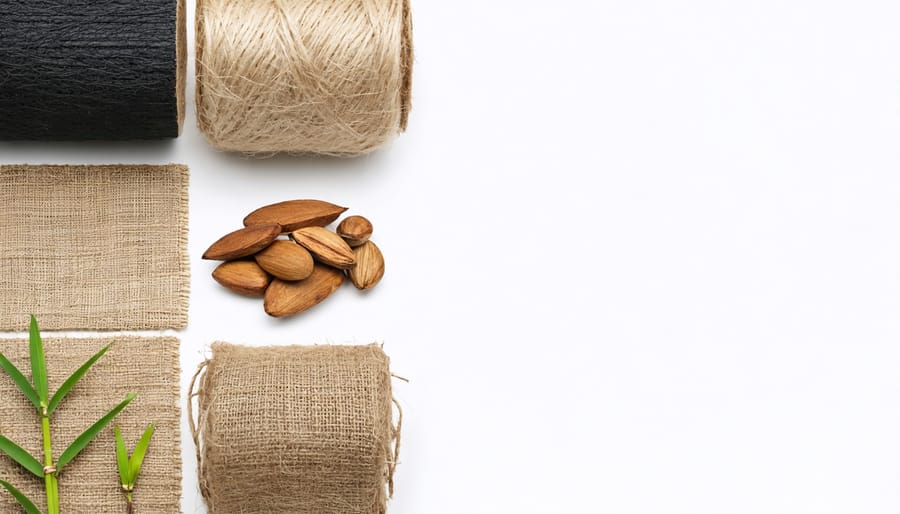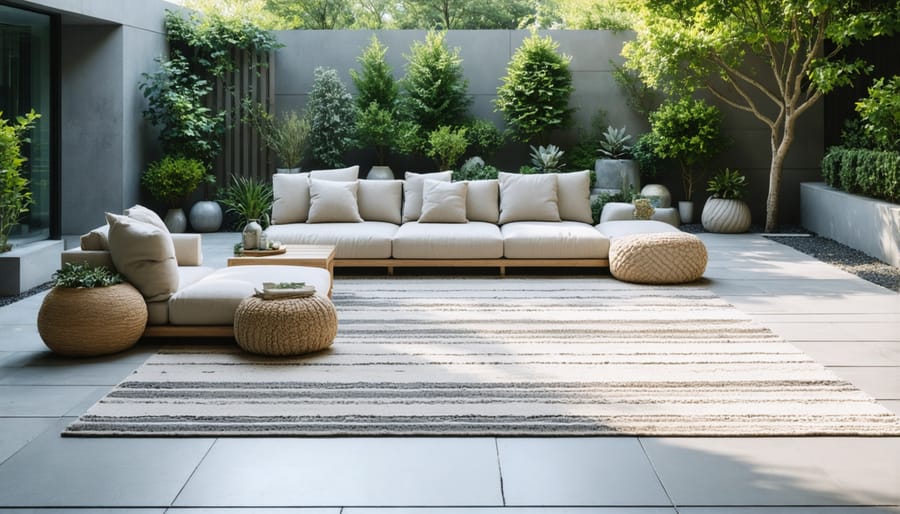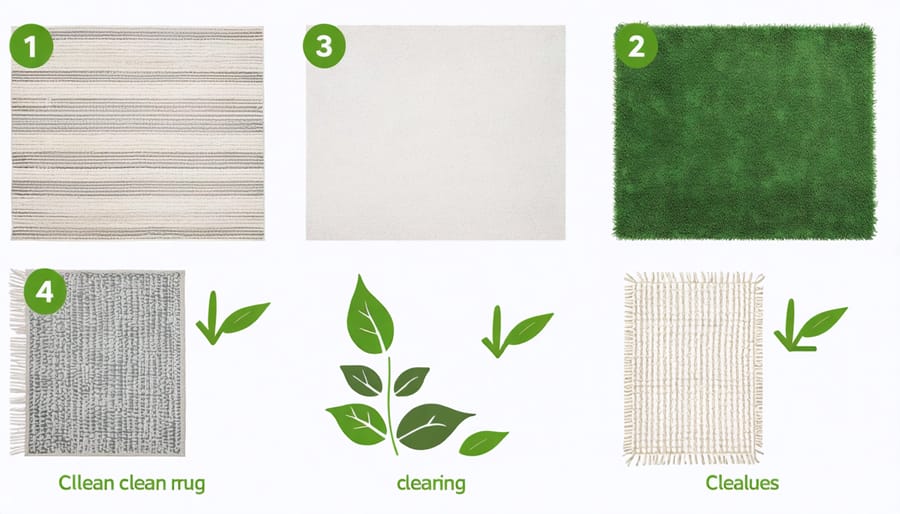Transform your outdoor space with eco-friendly rugs that blend style, sustainability, and durability. Made from recycled plastics, natural fibers, and renewable materials, these environmentally conscious floor coverings have revolutionized sustainable outdoor living. Unlike traditional synthetic rugs, eco-friendly alternatives resist mold, withstand harsh weather, and maintain their vibrant appearance while minimizing environmental impact. From repurposed maritime ropes to sustainably harvested jute and bamboo, these rugs offer a perfect balance of aesthetic appeal and environmental responsibility. Whether you’re designing a cozy patio retreat or creating an inviting garden sanctuary, eco-friendly outdoor rugs prove that conscious consumption doesn’t mean compromising on style or functionality. They’re not just accessories; they’re investments in both your outdoor space and our planet’s future.
What Makes an Outdoor Rug Truly Eco-Friendly?
Sustainable Materials
Today’s eco-friendly products offer innovative solutions for outdoor living spaces, and sustainable outdoor rugs are no exception. These rugs are crafted from a variety of earth-conscious materials that combine durability with environmental responsibility.
Recycled plastics, particularly PET from water bottles, have become a game-changer in outdoor rug production. These materials are transformed into soft, durable fibers that resist weather damage while keeping plastics out of landfills. Natural fibers like jute, sisal, and hemp provide excellent alternatives, offering biodegradable options that bring organic texture to your outdoor space.
Innovative eco-materials are also making waves in the industry. Bamboo-derived fabrics offer exceptional durability and natural water resistance, while reclaimed cotton fibers provide a sustainable solution for softer textures. Some manufacturers are even experimenting with marine plastic waste and agricultural byproducts, creating unique materials that help clean our oceans and reduce farming waste.
When choosing your outdoor rug, look for certifications like GRS (Global Recycle Standard) or GOTS (Global Organic Textile Standard) to ensure genuine sustainability claims.

Production Methods
Modern eco-friendly outdoor rugs are crafted using innovative, sustainable production methods that minimize environmental impact. Many manufacturers now employ closed-loop systems, which recycle water and materials throughout the production process, significantly reducing waste and resource consumption.
Leading sustainable rug makers utilize solar power and other renewable energy sources in their facilities. They also implement low-water dyeing techniques and natural coloring processes that avoid harmful chemicals. Some companies have pioneered methods to transform recycled plastic bottles and fishing nets into durable, UV-resistant fibers through a clean manufacturing process that produces minimal emissions.
Hand-weaving and traditional craft techniques are often incorporated, supporting artisan communities while reducing the need for energy-intensive machinery. Many producers also prioritize local sourcing of materials to minimize transportation emissions and support regional economies.
To ensure transparency, reputable manufacturers maintain strict ethical standards, providing fair wages and safe working conditions. They often hold certifications like GOTS (Global Organic Textile Standard) or GRS (Global Recycled Standard), validating their commitment to sustainable and ethical production practices.
Top Eco-Friendly Outdoor Rugs We’ve Tested
Recycled PET Options
Recycled PET (polyethylene terephthalate) rugs represent a brilliant intersection of sustainability and style in outdoor decor. These innovative rugs are crafted from recycled plastic bottles that would otherwise end up in landfills or oceans. On average, a 6×9 foot recycled PET rug can repurpose anywhere from 50 to 100 plastic bottles – that’s a significant environmental impact!
What makes these rugs particularly appealing for outdoor spaces is their inherent durability. The same properties that make plastic bottles weather-resistant work to your advantage in a rug. They’re naturally water-resistant, won’t fade in sunlight, and resist mold and mildew growth. Plus, they’re incredibly easy to clean – usually requiring just a quick spray with a garden hose.
You’ll find recycled PET rugs in an impressive array of styles, from bold geometric patterns to subtle natural weaves. The manufacturing process allows for vibrant, long-lasting colors that won’t fade, even under harsh sun exposure. The texture is surprisingly soft underfoot, unlike what you might expect from recycled plastic.
When shopping for recycled PET rugs, look for certifications that verify the recycled content. Many reputable manufacturers will specify the percentage of recycled materials used and their sourcing practices. While these rugs might cost slightly more than conventional options, their durability and eco-friendly credentials make them a worthwhile investment for your outdoor space.

Natural Fiber Solutions
Natural fibers offer some of the most sustainable and visually appealing options for outdoor rugs. Jute, with its soft, earthy texture, brings a warm, inviting feel to your outdoor space. While it’s incredibly eco-friendly and biodegradable, it’s best suited for covered outdoor areas as it can be sensitive to heavy moisture and direct sunlight.
Sisal, derived from the agave plant, is nature’s tough guy. These rugs are incredibly durable and resist staining, making them perfect for high-traffic outdoor areas. They have a naturally rough texture that’s great for scraping shoes clean and can withstand various weather conditions better than jute. The neutral, sandy color of sisal complements most outdoor décor styles while maintaining its eco-friendly appeal.
Bamboo rugs are rising stars in the sustainable outdoor rug world. This fast-growing grass requires minimal water and no pesticides to thrive, making it one of the most sustainable fiber choices available. Bamboo rugs offer excellent durability and natural water resistance, perfect for poolside areas or uncovered patios. They’re also naturally antimicrobial and come in various weaves and patterns, from sleek modern designs to traditional roll-up styles.
Pro tip: To extend the life of your natural fiber rug, consider rotating it every few months to ensure even wear and protect it from constant sun exposure in one area.
Innovative Sustainable Materials
Today’s sustainable outdoor rugs feature exciting new materials that combine eco-friendliness with durability and style. One standout innovation is recycled PET fiber, made from post-consumer plastic bottles. These rugs not only keep plastics out of landfills but also offer excellent weather resistance and easy maintenance.
Bamboo fiber blends are gaining popularity for their quick renewable properties and natural resistance to mold. When combined with recycled materials, they create rugs that are both sustainable and remarkably durable. Some manufacturers are even developing bamboo-based dyes that reduce chemical usage in the production process.
Another breakthrough comes in the form of seagrass and jute combinations. These natural fibers are being treated with eco-friendly water-resistant coatings, making them more suitable for outdoor use than ever before. The latest processing techniques allow these materials to maintain their natural texture while providing better resistance to moisture and UV rays.
Cork-infused materials are also making waves in the outdoor rug market. When blended with recycled synthetic fibers, cork adds natural water resistance and antimicrobial properties. This innovative combination creates rugs that are both environmentally conscious and highly functional.
Some manufacturers are now experimenting with reclaimed fishing nets and ocean plastics, transforming harmful marine debris into stylish outdoor rugs. These materials undergo special treatment processes to ensure they’re both durable and safe for household use.
Maintenance and Longevity

Cleaning and Care Tips
Keeping your eco-friendly outdoor rug looking fresh doesn’t require harsh chemicals or wasteful practices. By following these natural cleaning methods, you’ll extend your rug’s life while staying true to its sustainable nature.
For regular maintenance, simply shake out your rug weekly to remove loose dirt and debris. A good brushing with a soft-bristled brush helps prevent dirt from settling deep into the fibers. When dealing with spills, blot immediately with a clean cloth – avoid rubbing, as this can spread the stain and damage the fibers.
For deeper cleaning, mix equal parts water and white vinegar in a spray bottle. Test this solution on a small, inconspicuous area first. Spray lightly and use a soft brush to work the solution into the fibers. Allow the rug to dry completely in the sun, which naturally disinfects while eliminating odors.
During the peak outdoor season, consider these preventive measures:
– Rotate your rug monthly to ensure even wear
– Store during extreme weather conditions
– Use a rug pad underneath to prevent moisture buildup
– Clean spills immediately to prevent staining
– Air-dry only – avoid machine drying
For seasonal storage, ensure your rug is completely clean and dry, then roll it up (never fold) with a natural moth deterrent like cedar balls or lavender sachets. Store in a cool, dry place until next season.
Weather Protection Strategies
Protecting your eco-friendly outdoor rug from the elements is crucial for extending its lifespan and maintaining its beauty. Start by applying a non-toxic water repellent spray specifically designed for natural fibers – this creates an invisible barrier against moisture while preserving the rug’s sustainable qualities.
During heavy rain or severe weather, roll up your rug and store it in a dry, covered area. If that’s not possible, elevate the rug slightly off the ground using weatherproof rug pads to prevent water from pooling underneath. This simple step helps prevent mold and mildew growth while protecting your deck or patio surface.
Regular cleaning is essential for weather protection. Shake out your rug weekly to remove debris, and vacuum both sides monthly. For deeper cleaning, use mild, eco-friendly soap and water on a cloudy day to prevent fast drying that could leave soap residue. Always ensure the rug is completely dry before laying it back down.
Consider rotating your rug every few months to ensure even sun exposure and prevent fading. If possible, position it in partially shaded areas during peak summer months. For winter storage, clean thoroughly, treat with natural moth repellent, roll the rug (never fold), and wrap in breathable cotton or canvas before storing in a climate-controlled space.
These simple strategies will help your sustainable outdoor rug remain beautiful and functional for years to come, maximizing your eco-friendly investment.
Making the Right Choice
When selecting an eco-friendly outdoor rug, several key factors can help you transform your outdoor space while staying true to your environmental values. First, consider your specific climate conditions. If you live in a rainy area, look for rugs made from recycled plastics or PET materials, as they offer excellent water resistance while keeping plastics out of landfills. For sunnier regions, natural fiber rugs made from jute or sisal might be more appropriate, though they’ll need more protection from the elements.
Size matters significantly in outdoor spaces. Measure your area carefully, allowing for at least 18 inches of space between the rug’s edge and your furniture arrangement. This creates a balanced, welcoming look while ensuring your eco-friendly choice makes the impact you’re hoping for.
Think about foot traffic patterns in your outdoor area. High-traffic zones need more durable materials like recycled polyester or reclaimed maritime rope, while less-used spaces can accommodate more delicate natural fibers. Color choice is equally important – darker shades or patterns hide dirt better, requiring less frequent cleaning and extending the rug’s lifespan.
Consider the maintenance requirements of different materials. Some eco-friendly options, like bamboo or seagrass, may need more frequent cleaning or seasonal storage. Others, like recycled plastic materials, are virtually maintenance-free but should still be chosen from manufacturers with proven sustainable practices.
Finally, look for certifications that verify environmental claims. Labels like GRS (Global Recycled Standard) or GOTS (Global Organic Textile Standard) can help ensure your choice truly benefits the environment. Remember that the most sustainable option is one that lasts, so prioritize quality and durability alongside eco-friendly materials.
Making the switch to an eco-friendly outdoor rug is a meaningful step toward creating a more sustainable and beautiful outdoor living space. Throughout this guide, we’ve explored how these environmentally conscious rugs not only enhance your patio or deck but also contribute to a healthier planet. From recycled plastics to natural fibers like jute and sisal, there are numerous sustainable materials that offer both durability and style.
Remember to prioritize rugs made from recycled or renewable materials, and look for certifications that validate environmental claims. Consider your specific outdoor conditions when choosing between different materials, as some may be better suited to high-traffic areas or intense weather exposure than others.
Proper maintenance is key to extending your eco-friendly rug’s lifespan. Regular cleaning, proper storage during harsh weather, and addressing stains promptly will help preserve its appearance and functionality for years to come. By investing in a high-quality sustainable outdoor rug and caring for it properly, you’re not just creating an inviting outdoor space – you’re making an environmentally responsible choice that aligns with a sustainable lifestyle.
Whether you’re furnishing a small balcony or a sprawling patio, there’s an eco-friendly outdoor rug that perfectly matches your needs, style, and environmental values. Make your outdoor space both beautiful and sustainable with these conscious choices that benefit both your home and the environment.
